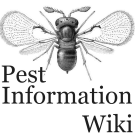Publications for:
pest = Ips subelongatus
country = China (NE)
found 10 publications:2021
Morphological and phylogenetic analyses reveal a new species of Ceratocystiopsis (Ophiostomataceae, Ophiostomatales) associated with Ips subelongatus in Inner Mongolia (China) with weak host pathogenicityForests (2021) 12 (12 - 1795)
publishers website - pestinfo wiki
Ophiostomatoid fungi including a new species associated with Asian larch bark beetle Ips subelongatus, in Heilongjiang (Northeast China)
Fungal Systematics and Evolution (2021) 8 (1), 155-161
publishers website - pestinfo wiki
2020
Ophiostomatoid fungi associated with Ips subelongatus, including eight new species from northeastern ChinaIMA Fungus (2020) 11 (3)
publishers website - pestinfo wiki
2016
Population divergence of aggregation pheromone responses in Ips subelongatus in northeastern ChinaInsect Science (2016) 23 (5), 728-738
publishers website - pestinfo wiki
2013
Responses of monophagous Ips subelongatus Motschulsky (Coleoptera: Curculionidae) and polyphagous Lymantria dispar L. (Lepidoptera: Lymantriidae) to tree species mixtureEntomological News (2013) 123 (1), 5-14
publishers website - pestinfo wiki
2011
Field responses of the Asian larch bark beetle, Ips subelongatus, to potential aggregation pheromone components: disparity between two populations in northeastern ChinaInsect Science (2011) 18 (3), 311-319
publishers website - pestinfo wiki
2010
Eight new Leptographium species associated with tree-infesting bark beetles in ChinaPersoonia (2010) 25, 94-108
publishers website - pestinfo wiki
2007
Electrophysiological and behavioral responses of Ips subelongatus to semiochemicals from its hosts, non-hosts, and conspecifics in ChinaJournal of Chemical Ecology (2007) 33 (2), 391-404
publishers website - pestinfo wiki
2006
Outcomes of the EPPO project on quarantine pests for forestryEPPO Bulletin (2006) 36 (3), 497-511
publishers website - pestinfo wiki
2000
Study on biological and ecological characteristics of Ips subelongatus MotschJournal of Forestry Research (2000) 11 (2), 114-118
publishers website - pestinfo wiki
